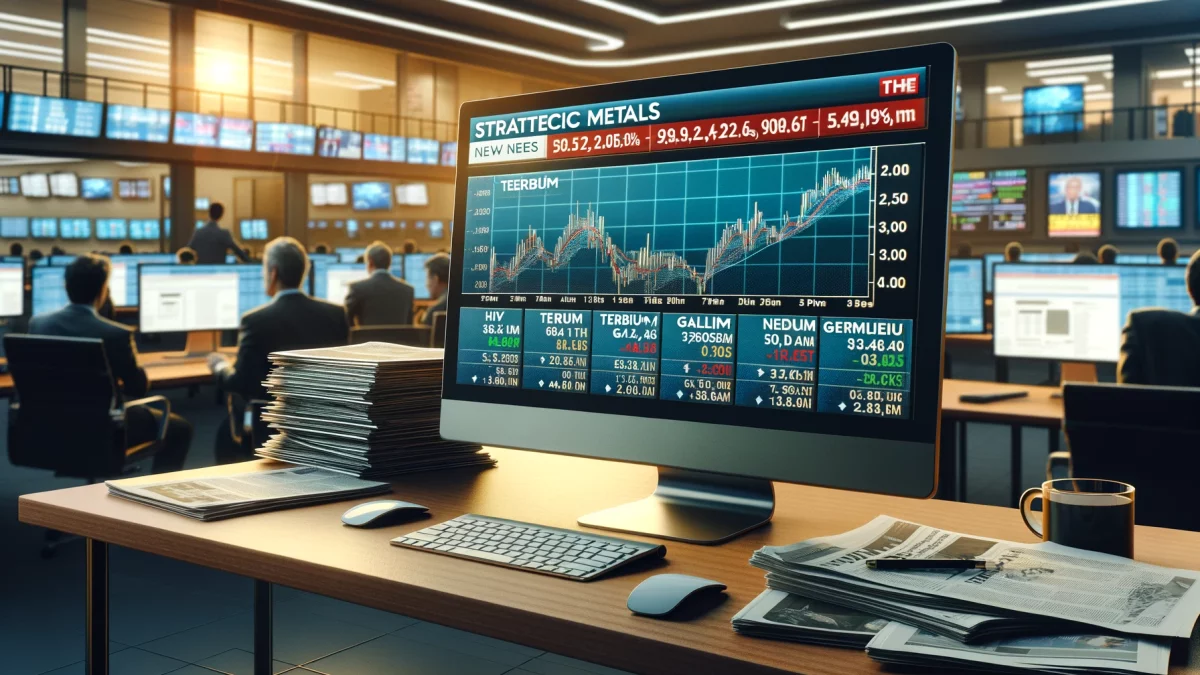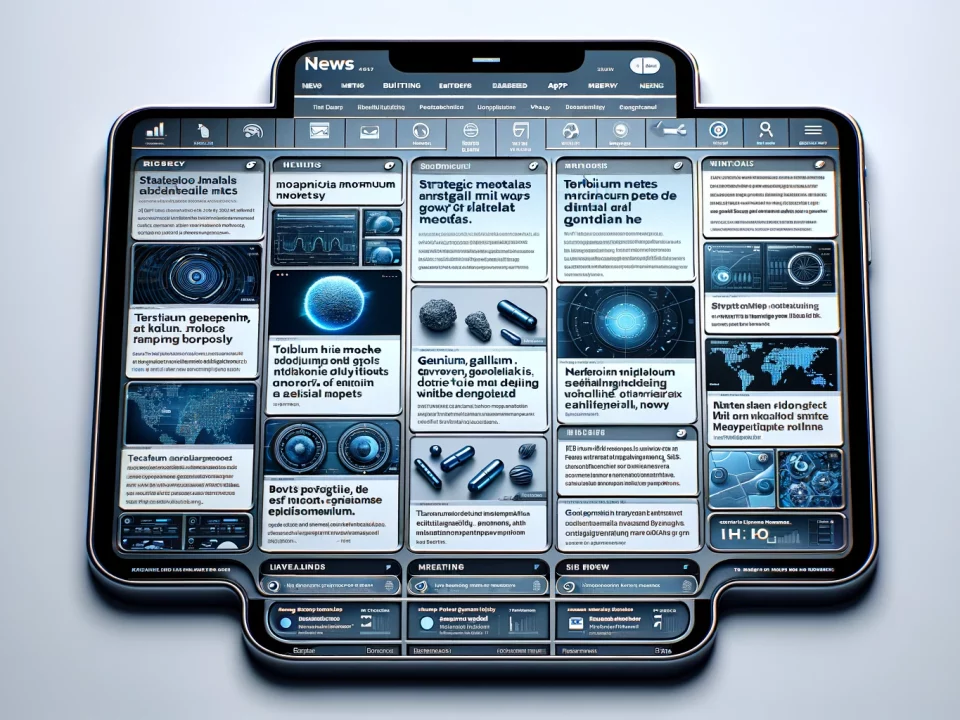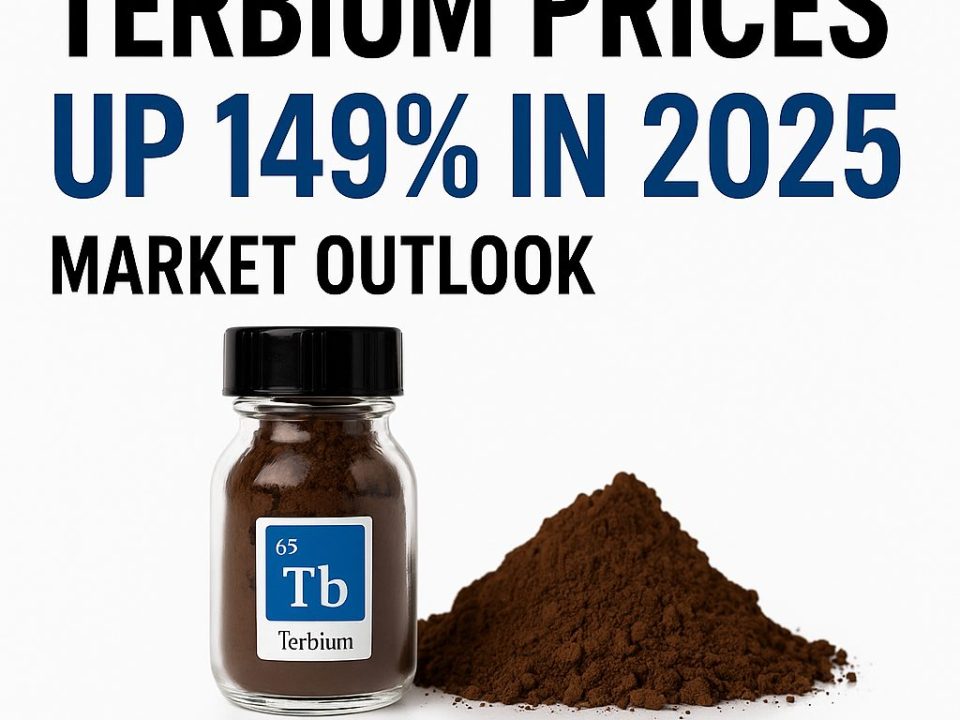
Weekly News Review October 13 – October 19 2025
October 19, 2025
Gallium Update: Up 32.5% So Far in 2025
October 28, 2025The signing of a U.S.–Australia critical minerals agreement set the tone this week, marking a significant step toward more resilient supply chains. At the same time, China’s latest export data showed mixed signals: both gallium and germanium shipments dropped in September, while dysprosium showed signs of recovering.
All this and more from the editorial team @rawmaterials.net
CHINA: GALLIUM AND GERMANIUM EXPORTS DROP SHARPLY IN SEPTEMBER –
Exports of both technology metals declined compared to August. Both have been subject to Chinese export controls for more than two years.
China’s exports of the technology metals gallium and germanium fell significantly in September, according to the latest data from the country’s customs administration.
A total of 5,000 kilograms of gallium were shipped abroad, about 30 percent less than in August. This follows a drop of more than 20 percent in July. Germany was the sole destination for gallium exports in September.
Exports of germanium declined even more sharply, falling 55 percent to 523 kilograms. The majority went to Russia (362 kilograms), followed by Germany (160 kilograms) and France (1 kilogram). Russia and Germany had already been the main destinations in August.
On an annual basis, shipments of both key high-tech raw materials have decreased. Only relatively small quantities now leave the country since China, the world’s leading producer, introduced strict export licensing requirements for gallium and germanium in mid-2023. In December 2024, China went a step further, imposing an explicit export ban on the United States, a move that continues to affect global supply chains.
CHINA: DYSPROSIUM EXPORTS CONTINUE TO RISE IN SEPTEMBER, TERBIUM SHIPMENTS EASE –
China’s latest customs figures show another strong month for dysprosium exports, while terbium shipments softened slightly compared to August.
A total of 18,043 kilograms of dysprosium were exported in September, the highest monthly volume since February, with more than 17,000 kilograms going to South Korea. Minor amounts went to Estonia, Portugal, and Thailand.
Terbium exports, meanwhile, edged down to 4,450 kilograms, following 5,500 kilograms in August. Almost all the material —4,000 kilograms —was shipped to Japan, with smaller quantities bound for Korea and Estonia.
Both elements remain subject to China’s export licensing system, introduced in April, requiring official approval before they can be shipped abroad. After an initial collapse in exports earlier this year, trade volumes have gradually recovered, particularly for dysprosium.
Dysprosium and terbium are key raw materials for the production of high-performance permanent magnets, which are essential components in electric vehicles, wind turbines, and a range of other advanced technologies.
CHINA: RARE EARTH MAGNET EXPORTS SLIGHTLY EASE IN SEPTEMBER:
China’s exports of rare earth magnets declined slightly in September following a strong rebound in the previous month. According to the latest data from Chinese customs authorities, total shipments reached 5,774 tons, down from 6,146 tons in August.
Germany was the largest recipient last month, importing 1,288 tons, followed by South Korea with 854 tons and Vietnam with 457 tons. All three countries are major automotive manufacturing hubs. Rare earth magnets are used not only in electric vehicle motors but also in conventional combustion engine vehicles, for example, in window regulators and air conditioning systems.
Exports had temporarily fallen earlier this year after Beijing introduced export controls on certain rare earth elements and related products. Because many magnets contain regulated elements and customs codes do not differentiate between compositions, approval procedures for all rare earth magnets were delayed, leading to temporary fluctuations in export volumes.
UNITED STATES AND AUSTRALIA SIGN CRITICAL MINERALS AGREEMENT, OUTLINE BILLIONS IN FINANCING:
The deal represents an “$8.5 billion pipeline,” the Australian Prime Minister said.
The United States and Australia agreed on a framework to strengthen supply chains for critical minerals. The deal, signed Monday at the White House by U.S. President Donald Trump and Australian Prime Minister Anthony Albanese, sets up the two governments to partner with the private sector to mobilize financial and regulatory support through guarantees, loans, equity, insurance, and fast-tracked permitting. Albanese said the agreement represents an $8.5 billion pipeline of investment-ready projects.
The framework commits both countries to mobilize more than $1 billion each in financing within six months to expand mining and processing capacity in their territories. Two projects have already been selected for immediate investment by the Australian government: Australian mining company Arafura Rare Earths will receive $100 million to advance its Nolans rare earth project, and U.S.-based aluminum producer Alcoa will receive $200 million to develop a gallium refinery in Western Australia in partnership with Japan’s Sojitz Corporation.
To safeguard national interests, the framework introduces new tools to review and block foreign acquisitions of strategic mineral assets. It also includes commitments to develop recycling technologies to reduce reliance on raw extraction.
U.S. Seeks to Diversify; Australia Positions Itself as Alternative to China
“This agreement underscores the depth of the U.S.–Australia alliance and our shared commitment to securing the critical minerals that will power the industries of the future,” Albanese said.
The framework agreement comes as the United States seeks to diversify its supply chains away from China, the world’s largest producer of critical minerals. Australia, meanwhile, aims to position itself as a reliable alternative supplier, drawing on its abundance of raw materials, including the world’s fourth-largest rare earth reserve. The deal follows China’s recent move to tighten its rare earth export rules, adding urgency to global efforts to build more secure and diversified supply chains.
AUSTRALIA: $52 MILLION FOR RARE EARTH PROJECT –
Financing offer from Australian Export Finance; raw materials from the Donald deposit to be processed in the U.S.
Australia’s Export Finance Agency (EFA) has extended a non-binding financing offer of up to USD 52 million for the domestic rare earth and zircon project Donald (PDF). The deposit, located in southeastern Australia, is being developed by the Australian Astron Corporation and the U.S. company Energy Fuels. Mining of rare earths from this mineral sands deposit could begin as early as 2027.
According to Astron (PDF), the project ranks among the three most significant rare-earth resources outside China and is also the world’s largest untapped zircon resource. In its first phase, the project is expected to produce over 7,000 tons of rare earth concentrate annually, including heavy rare earths, a segment currently dominated by China and subject to export restrictions. Company estimates suggest that production could meet approximately one-third of U.S. dysprosium demand and one-quarter of U.S. terbium demand. All raw material will be processed at Energy Fuels’ White Mesa Mill in Utah. The facility recently achieved a milestone in its pilot production of heavy rare-earth oxides (as we reported).
Donald Set to Benefit From Stronger Australian Government Support
One day before the financing announcement, the Australian government designated Donald as a “Major Project” (PDF), recognizing it as strategically important in economic, technological, and security terms. This designation allows Astron and Energy Fuels to benefit from closer engagement with federal agencies and support with permits and regulatory processes.
GERMANY, CANADA, USA SIGN 10-YEAR MAGNET RECYCLING AGREEMENT:
The Canadian company will recycle 100% of the by-products from magnet production.
German magnet materials manufacturer Vacuumschmelze (VAC) and Canadian recycling startup Cyclic Materials have expanded their collaboration with a 10-year exclusive agreement focused on magnet recycling. Under the deal, Cyclic will recycle 100% of the magnet production by-products from VAC’s facility in South Carolina, which is expected to begin operations later this year. It also includes the option to supply the recycled rare earth elements back to VAC, enabling the reintegration of the material into new magnet production. The new agreement builds on the companies’ previous partnership, which was signed in early 2024 (as we reported).
Founded in 2021, Cyclic Materials has developed proprietary technology to recover rare earth elements (REEs) from end-of-life products and other feedstocks—prominent investors, including Microsoft, Amazon, BMW iVentures, and others, back the company.
In April 2025, Cyclic Materials announced a $20 million investment in its first U.S. commercial facility in Mesa, Arizona, marking a significant step in its North American expansion.
FIGURE OF THE WEEK: – $150 Billion – would be lost in global output if just 10% of rare earth supplies would be disrupted.






